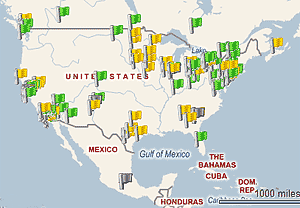 Yesterday, I talked about how two companies in the United Kingdom will perhaps be selling the first commercial hydrogen cars and fueling stations as early as this summer. Today, I would like to talk about how the rest of the European Union has mapped out its growth for a future filled with hydrogen cars.
Yesterday, I talked about how two companies in the United Kingdom will perhaps be selling the first commercial hydrogen cars and fueling stations as early as this summer. Today, I would like to talk about how the rest of the European Union has mapped out its growth for a future filled with hydrogen cars.
In the past I’ve talked about HyFLEET: CUTE, ECTOS, STEP and a few other EU roadmap projects. Now, its time to talk about Road2Hy.com (R2H), which is supported by the EU Framework Six program for sustainable development.
The purpose of R2H is to map the development of hydrogen and fuel cell technology within Europe, assess the current and future hydrogen production and distribution infrastructure and renewable resources used to build this infrastructure. Another purpose is to develop and report profiles for various “hydrogen communities” and map pathways from current mainstream technologies to future sustainable environments.
R2H will also identify both opportunities in technology and infrastructure and current gaps that need to be filled in order to move forward with a renewable and sustainable future. On the map on the top of this page (from Road2hy.com), the light green areas are countries with zero hydrogen fueling stations. The other areas of color contain a least one hydrogen fueling station.
 On the map of the U. S. (from h2stations.org) the green flags show hydrogen stations in operation, the yellow flags are stations that are planned and the gray flags are stations that are out of operation at this moment.
On the map of the U. S. (from h2stations.org) the green flags show hydrogen stations in operation, the yellow flags are stations that are planned and the gray flags are stations that are out of operation at this moment.
R2H shows a much clearer roadmap for participating countries for building hydrogen infrastructure than any kind of roadmap that the U. S. has been able to develop so far. To date, it has been up to the U. S. states partnering with industry to come up with their own funding for hydrogen infrastructure including fueling stations, production facilities and distribution centers. While the federal government does offer some support through the Department of Energy (DOE), this support is generally lacking when it comes to a nationwide rollout program for fueling stations.
According to the National Hydrogen Association list of U. S. H2 fueling stations the following states do not have one station active or planned: Alabama, Alaska, Arkansas, Georgia, Idaho, Iowa, Kansas, Kentucky, Louisiana, Maine, Maryland, Massachusetts, Minnesota, Mississippi, Montana, Nebraska, New Hampshire, New Jersey, Oklahoma, Oregon, Rhode Island, South Dakota, Tennessee, Utah, Washington, West Virginia, Wisconsin and Wyoming.
The areas where the NHA and H2stations.org two maps contradict are Georgia, Minnesota, Wisconsin, South Dakota, North Dakota primarily because the stations mentioned here are planned and not active and the northern states are part of the Upper Midwest Hydrogen Initiative that is not yet reflected on the NHA site. Oregon and Washington also have hydrogen highway systems in the planning stage that are not reflected on these maps.
Approximately 50-percent of the states in the United States do not have one hydrogen fueling station active yet. A slightly smaller percentage don’t even have them planned. In order to succeed with a nationwide hydrogen highway roadmap we need to take a page out of the playbook of Roads2Hy.com to make sure all states are represented in this national program, all voices heard, all votes for hydrogen cars counted. Federal intervention is needed if all 50 states and U. S. territories are represented in the national Hydrogen Highway system.
Great post, Kevin. Raising awareness about the U.S. hydrogen infrastructure is crucial to getting more hydrogen cars on the road. Hydrogen cars won’t be adopted without refueling infrastructure.
One explanation for the discrepancy between the NHA’s Fueling Station Database and that of H2Stations.org: many of the stations you mentioned, such as those proposed by the Upper Midwest Hydrogen Initiative, are not far enough along in the development process for the NHA to list them as “planned.” As these stations develop, you can be sure to find them on the NHA website.
Keep up the good work!
Thanks, Jesse, for the clarification and tor the NHA’s valuable resource that documents the building of the hydrogen fueling infrastructure.